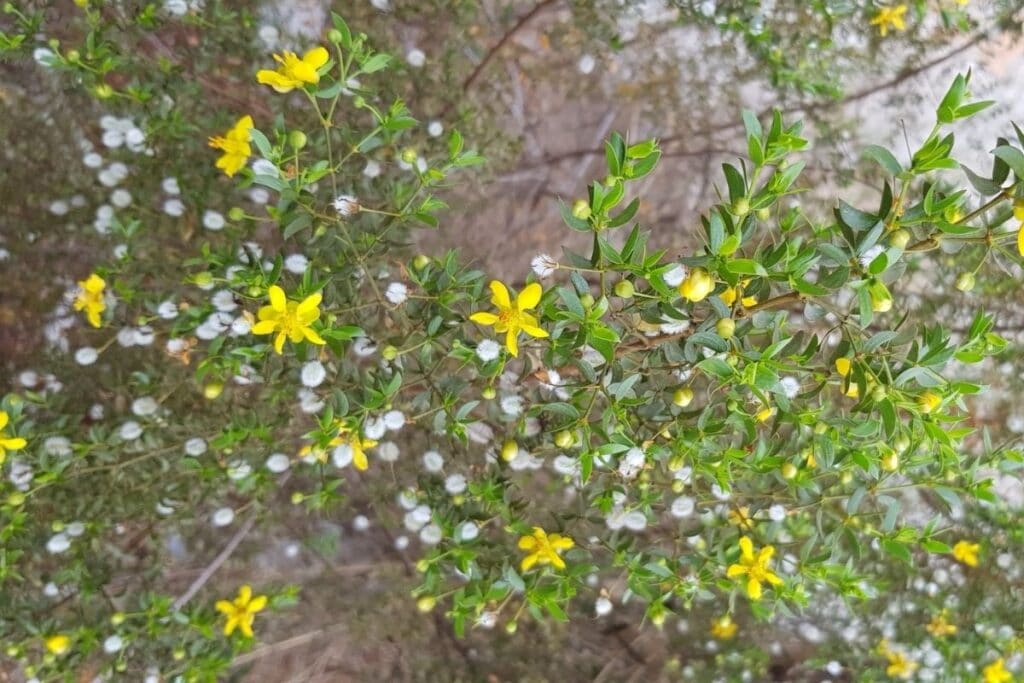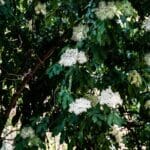If you live in a naturally hot and dry climate and are looking for an interesting low-maintenance plant for your garden, the creosote bush might be a perfect choice. These characteristic desert plants of the American Southwest are easy to grow where many other plants can’t.
Read on to learn how to grow and care for this interesting shrub – the Larrea tridentata.
What Is A Creosote Bush (Larrea tridentata)?
Larrea tridentata, commonly known as creosote bush, guamis, hediondilla, governadora, or greasewood is an American native shrub of the Zygophyllaceae family.
This is a slow process, however, and the oldest known clones of Larrea tridentata are estimated to be over 11 000 years old!
Creosote bush seeds need specific circumstances to germinate and mature into established plants because young plants only survive after long periods of unusually wet weather. This is why plants in the wild are often all of the same age.
Larrea tridentata occusr on well-drained soils on desert flats in western North America, including in the American Southwest in the states of California, Nevada, Arizona, New Mexico, and western Texas, extending south into northern Mexico. In these areas, the plants are associated with the smell of rain.
It is found in the Mojave, Sonoran, and Chihuahuan deserts. This evergreen shrub growing in places such as the Sonoran Desert Ecosystem has a variety of unique characteristics. Creosote leaves have the ability to capture more water than other plants and tolerate even alluvial soils.
Natural Environment and Adaptations
As an adaptation to their natural desert environment, creosote bushes have small, waxy leaves that can fold over to reduce their sun exposure and conserve water. The foliage consists of shiny light to dark green compound leaves with two leaflets about ¼ inch (6 mm) long, that are oppositely arranged.
These evergreen shrubs reach about 13 feet (4 m) tall at most, but they are pretty slow growing and make a fine shrub in the 3 to 5 feet (0.9 to 1.5 m) height range. These plants grow from multiple stems and tend to clone themselves, radiating outwards as the parent plant dies.
The plant has yellow flowers with vibrant yellow petals along with bright green leaves. Since its native to the southwestern deserts of southern Nevada, southeastern California, the Mojave Desert, and similar environments, it’s pretty obvious that those green leaves can tolerate dry soil and some serious water loss!
The leaves are resinous and sticky and give the plant its characteristic creosote smell. These plants also have interesting, light grey stems that have a jointed look as a result of dark rings at the nodes.
Distribution and Reproduction of the Creosote Bush + Key Takeaways
The spacing patterns of the creosote bush seem to be directly linked to its reproduction through clonal growth. The spacing distance between clones depends on soil water availability and water stress.
In the Johnson Valley, in the Mojave Desert of California, creosote bush clones grow in large rings that can be up to 1,000 years old, consisting of new shoots growing around the perimeter of the original plant. This phenomenon is best exemplified by the “King Clone,” believed to be one of the world’s oldest living organisms, estimated to be over 11,700 years old.
Despite their ability to reproduce asexually via clonal growth, the creosote bush also relies on sexual reproduction. In this case, the plant’s lightly headed yellow flowers facilitate wind dispersal, which contributes to the plant’s genetic diversity and subsequent adaptation to changing environmental conditions.
The Jepson Manual reports that creosote bush occupies a range of habitats, from creosote bush scrub to pinyon-juniper woodland, and forest service land management programs recommend that these desert shrubs be spaced carefully to maintain soil water and nutrient availability.
Creosote Bush (Larrea tridentata) Flowers
Creosote bush flowers are found singly in the leaf axils. Each flower measures about an inch (25mm) across and has 5 petals. These yellow flowers are absolutely breathtaking to behold.
These yellow flowers bloom most profusely in spring, although occasional flowering takes place in the summer and fall as well.
The yellow petals give way to small fluffy white fruits that turn reddish with age. Each capsule produces 5 seeds when mature.
How To Grow A Creosote Plant (Larrea tridentata)
The creosote bush can be grown from seed, although the seeds tend to be slow to germinate. Germination tends to be greater when seeds are scarified or abraded, but success of up to 90% has been achieved with intact seeds. These naturally spread via wind dispersal.
Seed can be collected from ripe fruits in the late spring and summer and will keep for as long as 8 years in a dry indoor environment.
These plants grow best in dry to lightly moist and well-drained soil. The substrate can be sandy, gravel, or rocky but neutral to alkaline soils are preferred.
The creosote plant is extremely drought resistant once established, but young plants are surprisingly sensitive to drought. This is why seedling success is so low in nature because long periods of unusually wet weather are required for establishment.
Mature plants that are given too much water tend to grow tall and thin so it is better to not water these plants too regularly. For the same reason, these plants are not really suited for gardens in high rainfall areas.
These plants should be grown in full sun and are hardy down to USDA zone 7. One thing to consider when planting creosote bushes in your garden is that other plants might not grow well under or near them. This is partly due to their very efficient and competitive root system.
Care and Maintenance
Creosote plant is a slow to moderately slow-growing shrub. These low-maintenance plants are long-lived, surviving for over a century before cloning.
They can be sheared, pruned as a neat, rounded shrub, or even trained as a small tree. Fertilizing is not necessary and these plants are naturally pest and disease resistant. They are, however, susceptible to pests known as creosote gall midges which cause the growth of galls on the plant.
Common Problems With the Creosote Plant
Creosote plants are fairly hardy and can tolerate all kinds of issues. They are drought tolerant and love dry soil.
This plant is known for its characteristic odor and its resinous molecules that protect it from herbivores and diseases. However, despite its amazing adaptability to harsh environments, it can encounter some problems that may limit its growth rate and affect its health.
One of the major challenges that the creosote plant faces is the infestation by the creosote gall midge, a tiny insect that lays eggs in the stems and leaves of the plant, causing the formation of galls that can distort, weaken, and even kill the affected parts. The creosote gall midge also disrupts the normal flow of nutrients and water in the plant, hampering its ability to perform photosynthesis, which is essential for its survival.
In addition to the creosote gall midge, the creosote plant can also suffer from a lack of water, which is a common problem in arid environments.
The creosote plant has developed some adaptations to cope with water scarcity, such as having a deep root system that can reach water sources underground and reducing its leaf size and number to minimize water loss through transpiration.
However, if the water deficit persists for a long time or if the groundwater is depleted or contaminated, the creosote plant may not be able to maintain its growth rate and may even die. Therefore, providing more water to the plant may be necessary in extreme situations to boost its growth rate.
Creosote Bush Uses
Now that you know everything there is to know about how to care for your Larrea tridentata plants, here are some potential other uses.
Horticultural Uses
The Larrea tridentata is best suited for use in xeriscapes and gardens in dry, low-rainfall areas. There they can be used in borders and rock gardens or left to naturalize. They make an interesting specimen plant and can be grown as an informal hedge.
Human Uses
Although it is considered dangerous and toxic in modern medicine, this plant has a long history of medicinal uses. Creosote leaves were used to treat a variety of conditions including snake bites, tuberculosis, menstrual cramps, and as a poultice on wounds.
These medicinal properties of the plant have been valued for more than a thousand years and the plant is revered in the California press, the Arizona press, and so much more. It’s protected by the National Park Service as one of the most valuable plants in our desert ecosystems.
Wildlife Uses
Few animals feed on the bitter leaves of the creosote bush but the flowers are popular with pollinators like bees and other insects. This plant is deer resistant.
FAQs
Conclusion
For gardeners in the dry, American southwest, the creosote is a tough, low maintenance but attractive evergreen shrub that will thrive where many other plants can’t survive. These interesting plants may be slow-growing, but they certainly do add character and color to the landscape.
References
References List:
- Marshall, K. A. Larrea tridentata. In: Fire Effects Information System.
U.S. Department of Agriculture
https://www.fs.fed.us/database/feis/plants/shrub/lartri/all.html
- Busing, R. T. Larrea Tridentata: The Woody Plant Seed Manual.
- California Native Plant Society. Creosote Bush
Close
*image by shahla_bluerich/depositphotos







